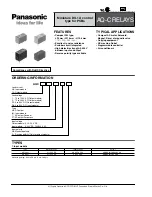
-- -,;;:;;:;::--- ----;;:;:;>"---·---�----,----
I. L. 41-600.3
O
P
E
R
A
T
O
N
O
F
S
C
H
E
M
E
INSTRUCTIONS
TYPE HKB CARRIER BELAYING
INTRODUCTION
The high-speed
clearing of faults on trans
mission lines is
recognized as
necessary for
good
system operation.
The
best
overall
protection
is provided by th� method known as
differential relaying in which conditions at
the two ends
of the line
are compared to de
termine
whether
the fault
is in the line
section
or external to the
protected "' zone.
This assures simultaneous
tripping
of
the
breakers,
which is desirable from the
stand
points of stability,
continuity
of service,
quick reclosing,
and minimum damage to equip
ment.
For many lines, carrier relaying is the
most practical
and reliable
medium
for com
paring the conditions
at
the two ends of the
line.
system
relay
of carrier protection
operating
(
on current
The type
HKB
uses
a single
only
)
at
each
end
of the transmission line
section to detect and determine the
location
of faults.
It compares over
a
carrier
pilot
channel the phase angle between
the two ends of a line section
currents
at
to determine
whether
an internal or external fault exists.
A positive, negative and zero sequence cur
rent
filter is used to obtain a single-phase
voltage
from the
three-phase
line currents,
and this voltage is utilized to energize fault
detectors and to
control the transmission of
alternate
half cycle
blocks
(
at the
power
frequency
)
of carrier energy from both ends of
the line section.
The carrier signal from each end is received
at the
opposite
end of the
line where it is
rectified,
and
compared with the phase po
sition
of the
output
voltage
of the local
sequence filter.
This compRrison takes
place
in the grid circuit of a
vacu�m tube which is
NEW INFORMATION
so biased
that no plate
current
flows
when
there
is no filter or carrier
voltage on its
control grid.
The polarity of the filter and
carrier voltages is such that no current flows
in the vacuum tube plate circuit for a fault
external
to the
protected line
section when
the line �urrents
are exactly in phase at the
two ends.
For an internal fault with the cur
rents at the two ends or the line
180°
out-of
phase, plate
current will flow
on alternate
half-cycles
of
the
line
current frequency.
This plate current flows through a transformer
primary winding, and the a-c voltage developed
on the
secondary
side
is rectified
and
supplied to a relay whose
contact is in the
trip circuit.
The voltage in the transformer
secondary is sufficient to trip
the relay for
an internal fault.
This arrangement thus pro
vides simultaneous tripping
over the entire
line section for all
faults within the set
tings
of the relay.
As this system operates
on
line current only, it is not sub
j
ect to
tripping on power swing
or out-of-synchronism
conditions since
the
circulating
currents
appear to the relays as "·n external fault.
If
tripping is desired on an out-of-synchronism
condition, auxiliary
relays must be added for
this purpose.
For an internal fault on a line
fed from one end only, tripping will occur
at
the
terminal
through which
fault current is
flowing into the line section.
COMPONENTS OF COMPLETE
EQUIPMENT
An outline
of the equipment
used at each
terminal
of a transmission line section is as
follows:
l.
One type
HKB
relay which
includes the
sequence filter,
fault detectors
to
start the transmlssion of
carrier
and
control the operating element
(
tripping
EFFECTIVE 7-47
www . ElectricalPartManuals
. com
www
. ElectricalPartManuals
. com






















